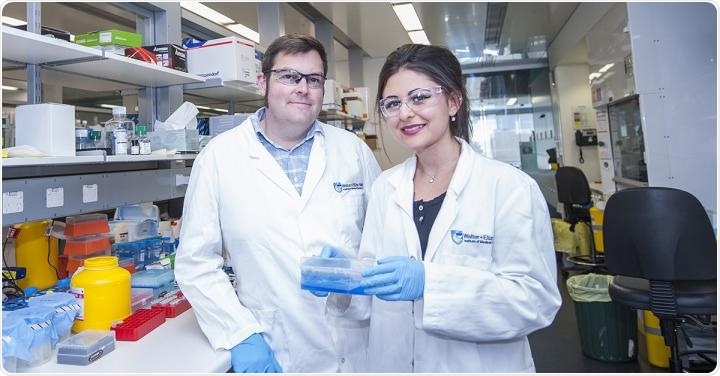Researchers have used structural biology to map a portion of a protein called SMCHD1, describing how certain modifications in the SMCHD1 protein can lead to specific developmental and degenerative conditions.

Associate Professor James Murphy (L) and PhD student Ms Alexandra Gurzau (R) were part of a team who have extended the “map” of the gigantic protein SMCHD1. Image Credit: Walter and Eliza Hall Institute, Australia.
The study was published in the Science Signaling journal. The researchers from the Walter and Eliza Hall Institute uncovered the structure of the part of the SMCHD1 protein that is key to its function in “switching off” genes. Inherited mutations in this portion of the SMCHD1 protein have been associated with a developmental disorder as well as a form of muscular dystrophy.
The research project, which took a total of 10 years, was headed by Dr Kelan Chen, Ms Alexandra Gurzau, Dr. Richard Birkinshaw, Associate Professor James Murphy, Professor Marnie Blewitt, and Associate Professor Peter Czabotar.
At a glance
- Sophisticated structural biology approaches have been employed to expose a new map of a part of the SMCHD1 protein.
- The novel structure offers more detail about how the SMCHD1 protein works to modify the expression of genes.
- The researchers have used the structure to gain a deeper insight into how inherited modifications in the SMCHD1 gene change its function and cause-specific developmental and degenerative diseases.
Regulating gene expression
The human genome consists of around 20,000 genes that control the synthesis of proteins inside cells, impacting the function of cells. Genes can be “switched on” or “switched off” at different times and in different types of cells, modifying the amounts of the related protein inside the cells and changing the behavior of the cells. The perfect balance of this gene “expression” is crucial for healthy development and all through life.
SMCHD1 is a form of protein that can particularly turn off genes, thus affecting the function of cells. Alexandra Gurzau stated that inherited changes in the SMCHD1 protein have been associated with a form of muscular dystrophy, known as facioscapulohumeral dystrophy (FSHD), and a rare developmental disorder known as Bosma arhinia microphthalmia syndrome (BAMS).
By investigating the structure and biology of SMCHD1, we hope to better understand the diseases that are associated with changes in SMCHD1, as well as revealing how this protein functions in healthy cells.”
Alexandra Gurzau, PhD Student, Department of Medical Biology, University of Melbourne
Gurzau continued, “Some of the changes in SMCHD1 that cause disease occur in one part of SMCHD1—called its ‘hinge domain’—that binds to DNA and also enables SMCHD1 proteins to clump in pairs, called dimers. This part of the protein was very poorly understood, so we focused our attention on it and investigated its structure.”
A challenging protein
Dr. Richard Birkinshaw stated that the SMCHD1 was a specifically challenging protein to describe a structure for.
This protein was about five times bigger than a typical human protein, and its hinge domain had a number of features that made it hard to purify and crystalize, two essential steps before we could determine its structure.”
Dr Richard Birkinshaw, Department of Medical Biology, University of Melbourne
Dr. Birkinshaw continued, “It was a long process, started by Dr. Kelan Chen and involving the CSIRO C3 Collaborative Crystallization Centre, but we eventually were able to apply advanced technologies at the Australian Synchrotron called ‘single anomalous dispersion’ and ‘small-angle X-ray scattering’ to solve the structure of the SMCHD1 hinge domain.”
“This created a three-dimensional ‘map’ of this part of the protein, showing its shape and the spatial connections between its different parts,” he further stated. According to Gurzau, the structure showed how the SMCHD1 protein adheres to DNA and which portions of the protein allowed it to bind with its pair.
Ms. Gurzau added, “We could also deduce from the structure why some disease-associated changes in the hinge domain prevent SMCHD1 from functioning. By recreating these different forms of the protein within cells, we were able to use imaging to visualize how these variants behaved differently from the unchanged version of SMCHD1—an important advance in understanding the associated diseases.”
Dr. Birkinshaw stated that the structure of the SMCHD1 protein also upended algorithms that had been created to estimate the structure of unidentified proteins.
The structures of many ‘SMC’ proteins related to SMCHD1 had already been solved, but our work revealed the structure of the SMCHD1 hinge domain is quite different from equivalent regions in these proteins. Our data is now being used as a challenge for structure prediction algorithms, as the structure we discovered is quite different from what we had expected.”
Dr Richard Birkinshaw, Department of Medical Biology, University of Melbourne
Birkinshaw continued, “This challenge tests which of these algorithms can most accurately predict our structure and helps to improve the algorithms to produce more accurate models.”
Associate Professor James Murphy stated that the current findings which supplemented the team’s study into designing drugs that modify the function of the SMCHD1 serve as a potential novel therapy for certain diseases linked to the protein.
“By understanding in more detail how SMCHD1 functions, we can better understand its role in health and disease. Another group had already solved the structure of a separate part of the protein, so we’ve added more detail to the entire protein’s structure— although half of the protein is still ‘uncharted’,” Murphy concluded.
Source:
Journal reference:
Chen, K., et al. (2020) Crystal structure of the hinge domain of Smchd1 reveals its dimerization mode and nucleic acid–binding residues. Science Signaling. doi.org/10.1126/scisignal.aaz5599.